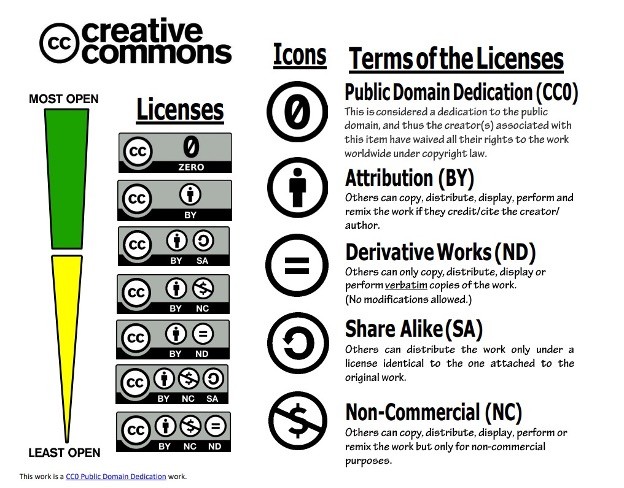
There are six different license types, listed from most to least permissive here:
CC BY
 This license enables reusers to distribute, remix, adapt, and build upon the material in any medium or format, so long as attribution is given to the creator. The license allows for commercial use. CC BY includes the following elements:
This license enables reusers to distribute, remix, adapt, and build upon the material in any medium or format, so long as attribution is given to the creator. The license allows for commercial use. CC BY includes the following elements:
 BY: credit must be given to the creator.
BY: credit must be given to the creator.
CC BY-SA
 This license enables reusers to distribute, remix, adapt, and build upon the material in any medium or format, so long as attribution is given to the creator. The license allows for commercial use. If you remix, adapt, or build upon the material, you must license the modified material under identical terms. CC BY-SA includes the following elements:
This license enables reusers to distribute, remix, adapt, and build upon the material in any medium or format, so long as attribution is given to the creator. The license allows for commercial use. If you remix, adapt, or build upon the material, you must license the modified material under identical terms. CC BY-SA includes the following elements:
 BY: credit must be given to the creator.
BY: credit must be given to the creator.
 SA: Adaptations must be shared under the same terms.
SA: Adaptations must be shared under the same terms.
CC BY-NC
 This license enables reusers to distribute, remix, adapt, and build upon the material in any medium or format for noncommercial purposes only, and only so long as attribution is given to the creator. CC BY-NC includes the following elements:
This license enables reusers to distribute, remix, adapt, and build upon the material in any medium or format for noncommercial purposes only, and only so long as attribution is given to the creator. CC BY-NC includes the following elements:
 BY: credit must be given to the creator.
BY: credit must be given to the creator.
 NC: Only noncommercial uses of the work are permitted.
NC: Only noncommercial uses of the work are permitted.
CC BY-NC-SA
 This license enables reusers to distribute, remix, adapt, and build upon the material in any medium or format for noncommercial purposes only, and only so long as attribution is given to the creator. If you remix, adapt, or build upon the material, you must license the modified material under identical terms. CC BY-NC-SA includes the following elements:
This license enables reusers to distribute, remix, adapt, and build upon the material in any medium or format for noncommercial purposes only, and only so long as attribution is given to the creator. If you remix, adapt, or build upon the material, you must license the modified material under identical terms. CC BY-NC-SA includes the following elements:
 BY: credit must be given to the creator.
BY: credit must be given to the creator.
 NC: Only noncommercial uses of the work are permitted.
NC: Only noncommercial uses of the work are permitted.
 SA: Adaptations must be shared under the same terms.
SA: Adaptations must be shared under the same terms.
CC BY-ND
 This license enables reusers to copy and distribute the material in any medium or format in unadapted form only, and only so long as attribution is given to the creator. The license allows for commercial use. CC BY-ND includes the following elements:
This license enables reusers to copy and distribute the material in any medium or format in unadapted form only, and only so long as attribution is given to the creator. The license allows for commercial use. CC BY-ND includes the following elements:
 BY: credit must be given to the creator.
BY: credit must be given to the creator.
 ND: No derivatives or adaptations of the work are permitted.
ND: No derivatives or adaptations of the work are permitted.
CC BY-NC-ND
 This license enables reusers to copy and distribute the material in any medium or format in unadapted form only, for noncommercial purposes only, and only so long as attribution is given to the creator. CC BY-NC-ND includes the following elements:
This license enables reusers to copy and distribute the material in any medium or format in unadapted form only, for noncommercial purposes only, and only so long as attribution is given to the creator. CC BY-NC-ND includes the following elements:
 BY: credit must be given to the creator.
BY: credit must be given to the creator.
 NC: Only noncommercial uses of the work are permitted.
NC: Only noncommercial uses of the work are permitted.
 ND: No derivatives or adaptations of the work are permitted.
ND: No derivatives or adaptations of the work are permitted.
The CC0 Public Domain Dedication
 CC0 (aka CC Zero) is a public dedication tool, which enables creators to give up their copyright and put their works into the worldwide public domain. CC0 enables reusers to distribute, remix, adapt, and build upon the material in any medium or format, with no conditions.
CC0 (aka CC Zero) is a public dedication tool, which enables creators to give up their copyright and put their works into the worldwide public domain. CC0 enables reusers to distribute, remix, adapt, and build upon the material in any medium or format, with no conditions.
© 2019. This work is openly licensed via CC BY 4.0.


